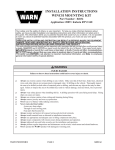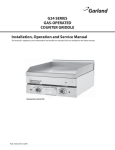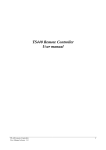Download RS-232C Line Driver User Manual
Transcript
RS-232C Line Driver User Manual Read this manual thoroughly and follow the installation procedures carefully to prevent any damage to the IC-150 and/or the devices it connects to. All brand names and trademarks are the registered property of their respective owners. Packing Checklist 1 x IC-150 Line Driver 1 x User's Manual If anything is damaged or missing, contact your dealer. NOTE: This equipment has been tested and found to comply with the limits for a Class A digital device pursuant to Part 15 of the FCC Rules. These limits are designed to provide reasonable protection against harmful interference when the equipment is operated in a commercial environment. This equipment generates, uses, and can radiate radio frequency energy and, if not installed and used in accordance with the instruction manual, may cause harmful interference to radio communications. Operation of this equipment in a residential area is likely to cause harmful interference, in which case the user will be required to correct the interference at his own expense. Overview The non powered IC-150 Line Driver facilitates efficient transmission and reception of serial data without requiring an external power source. The unit drives your data at various speeds up to 19,200 bps over distances up to 0.5 miles using 24-gauage wire (transmitting at 110 bps over distances up to 6.3 miles). Note that the slower the speed, the greater the distance, and transmission performance may vary depending on operating conditions and wire gauge. The IC-150 provides 1,500VAC lighting surge protection and excellent noise rejection through the use of differential circuitry. The unit is switch-selectable for DCE/DTE. It provides asynchronous transmission and operates full-duplex over four wires. This compact unit plugs directly into the back of your asynchronous terminal, which saves the space that a standalone unit would use, and also eliminates the bulk and cost of a separate RS-232 interface (which requires a +12V DC source). Therefore, the IC-150 does not need a separate outlet or power supply. Features DCE / DTE selectable External Power Not Required - Power supplied by the RS-232 interface Compact size Switch Configuration The IC-150 is configured by setting two slide switches. SW1 is used to select the Device Mode; SW2 is used to select the Transmission Mode, as shown in the table below: Position SW1 SW2 1 DCE Full Duplex 2 DTE DCE, Tx or DTE, Rx 3 Loop Back DCE, Rx, or DTE, Tx Note: DCE means Date Communication Equipment; DTE means Date Terminal Equipment. Device Mode Selection The Device Mode is selected with SW1, as shown in the table, below: SW1 Operating Position Mode 1 DCE Meaning The IC-150 is set to DCE mode and must be connected to a DTE device. 2 DTE The IC-150 is set to DTE mode and must be connected to a DCE device. 3 Loop Back The IC-150 is set to Monitor mode and monitors the phone line signals. Transmission Mode Selection The Transmission Mode is selected with a combination of SW1 and SW2. Choices are Full Duplex, or Simplex (Tx Only or Rx Only), as shown in the table, below: SW2 Operating Mode Position 1 Full Duplex. The IC-150 transmits and receives simultaneously. With this mode, it doesn't matter what SW1 is set to. 2 DCE Tx / DTE Rx: if SW1 is set to DCE (SW1 pos. 1), the IC-150 only transmits; if SW1 is set to DTE (SW1 pos. 2), the IC-150 only receives. 3 DCE Rx / DTE Tx: if SW1 is set to DCE (SW1 pos. 1), the IC-150 only receives; if SW1 is set to DTE (SW1 pos. 2), the IC-150 only transmits. Switch Setup Summary The above considerations can be summarized in the following table: IC-150 Operating Mode SW1 SW2 Full Duplex X 1 Simplex DCE Transmit 1 2 Simplex DCE Receive 1 3 Simplex DTE Transmit 2 3 Simplex DTE Receive 2 2 Loop Back 3 X Note: 1. An X in the table means it doesn't matter what the switch is set to. 2. If the IC-150 is set as a DCE device, it must connect to a DTE device (and vice versa). Operation You should be aware of the following considerations when operating the IC-150: The digital interface is RS-232C/CCITT V.24. When in Full Duplex, only software handshake (i.e. Xon/Xoff or ETX/ACK) is applicable via TD and RD. When in Simplex, only hardware handshake (DTR/DSR) is applicable. The unit is powered from host RS-232C interface (MC1488, SN75188 or equivalent ICs). The interface must provide greater than +9V of power. In addition to the TD line, the computer or terminal must at least also support the RTS line; the DTR line; or both. IC-150 Configuration Table IC-150 Function Table Function (1) Full Duplex: A and B may both transmit and receive. They only use software handshake Function (2: Simplex: A is the transmitter; B is the receiver. Function (3) Simplex: B is the transmitter; A is the receiver. Function (4) Loop Back: A monitors the phone line data transmission (for self-test only). Note: In Simplex Mode, only hardware handshaking (DTR/DSR) applies. Appendix RS-232 Pin Outs DTE Mode: Pin Name Function 1 PG Protective Ground 2 TD Transmit Data 3 RD Receive Data 4 RTS Request to Send (connected with pin 5) 5 CTS Clear to Send (connected with pin 4) 6 DSR Data Set Ready 7 SG Signal Ground 8 CD Receive Line Signal Detector 20 DTR Data Terminal Ready DCE Mode: Pin Name Function 1 PG Protective Ground 2 RD Receive Data 3 TD Transmit Data 4 CTS Clear to Send (connected with pin 4) 5 RTS Request to Send (connected with pin 5) 6 DTR Data Terminal Ready 7 SG Signal Ground 8 CD Receive Line Signal Detector 20 DSR Data Set Ready Specifications Function Specification Power Supply No external power. Power derived from RS-232 interface. Data Rate Up to 19,200 bps under 0.5 miles. Connectors • 1 x DB-25 female • 1 x 4 Post Terminal Block • 1 x RJ-11 Socket Function Switches SW1 DCE / DTE / Loop Back Select SW2 Full Duplex / Simplex Select Housing Plastic Weight 60 g Dimensions (L x W x H) 54 x 74.5 x 18.5 mm Distance / Data Rate Table Distance bps Wiring kms miles 110 10 6.3 1200 7 4.4 2400 5 3.1 4800 3.5 2.2 9600 2 1.3 19200 0.8 0.5 24 AWG two twisted pairs. Troubleshooting Symptom Action Data Transmission Check that the IC-150 units are securely plugged into the computers' serial Failure ports. Check that the cables are properly set up and properly connected. Check that SW1 and SW2 are set properly. Check that a device configured as DCE is connected to one configured as DTE (and vice versa). Data Loss or Error Check that pins 4, 5, 6, 8, and 20 carry ± 9V DC.














